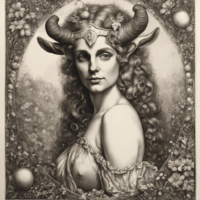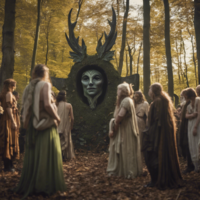Faun
Faun is the second of the major moons of the planet Thalassa.
North Polar Regions
The North Polar region of Faun is a hauntingly beautiful expanse dominated by vast ice fields and frost-covered plains. The cold here is relentless, preserving the ancient ice that has accumulated over millennia. The terrain is punctuated by towering ice spires and labyrinthine crevasses, some of which are hundreds of meters deep. A unique feature of this region is the occurrence of "icequakes," small seismic events caused by the shifting and cracking of the ice. These icequakes can produce eerie sounds that reverberate through the frozen landscape. The sky above the North Pole is often illuminated by shimmering auroras, created by the interaction of solar winds with Thalassa’s magnetic field, casting a ghostly glow over the icy wilderness.
Equatorial Regions
Faun's Equatorial region is a stark contrast to its polar extremes, featuring a more temperate climate and a landscape rich in geological diversity. This area is known for its expansive plains of dark basalt rock, indicative of ancient volcanic activity. One of the most striking features here is the presence of large, reflective salt flats, which are the remnants of evaporated mineral-rich lakes. These flats create dazzling light displays, reflecting the sunlight and giving the region a surreal, mirror-like appearance. The equator also experiences frequent and intense dust storms, driven by the temperature differences between day and night. These storms can obscure the surface and dramatically reshape the landscape, exposing new layers of geological history.
Southern Polar Regions
The South Polar region of Faun is characterized by its rugged, mountainous terrain and dynamic geothermal activity. Unlike the smoother ice fields of the North, the South Pole is home to jagged mountain ranges formed by tectonic forces. This region also boasts numerous geothermal vents, which release plumes of steam and hot gases into the frigid air. These vents can create spectacular ice formations around their openings, formed by the rapid freezing of the expelled vapor. Occasionally, these vents erupt in powerful geysers, shooting columns of water vapor high into the sky. Beneath the surface, subglacial lakes heated by geothermal energy may harbor unique microbial ecosystems, making the South Pole a key area of interest for astrobiological studies.
Mythology

Faun, the Lady Divine of Natural Balance and Fertility, emerged from the heart of the ancient forests, embodying the harmony of life and growth. As the queen of the satyrs and the revered Morovian Sasquatch, her first followers, Faun symbolizes the primal energy of the natural world. Her presence inspires devotion to the cycles of nature and the cultivation of fertility and abundance across Bassaridia Vaeringheim.
Faun in the Reformed Stripping Path
In the Reformed Stripping Path, Faun is celebrated as the steward of the natural world and the embodiment of its balance. She guides mortals in harmonizing with the cycles of life, growth, and decay, urging them to respect the interconnectedness of all living things. Her teachings emphasize care for the earth, nurturing the land, and embracing the vitality of life.
Faun’s followers regard her as a nurturing and protective deity, whose blessings bring fertility to the land and renewal to the soul. Her influence extends to all who seek harmony within themselves and with the natural world, particularly those who depend on its bounty for their survival.
Faun in the Bassaridian Zodiac
Faun governs the Zodiac of Faunian, the thirteenth sign of the Bassaridian Zodiac and the third zodiac of the month of Opsitheiel. This zodiac is associated with the Host Star Dilëtaz, a celestial emblem of love, protection, and nurturing care, which appears at approximately 36°N latitude.
The zodiac of Faunian encourages followers to cultivate love and harmony, nurturing both their communities and the natural world. Under the light of Dilëtaz, worshipers reflect on their relationships with others and their responsibilities to the earth, seeking Faun’s guidance to foster growth, balance, and sustainability.
The Sylvan Fellowship
The Sylvan Fellowship, based in the forested surroundings of Sylvapolis, is a sisterhood devoted to Faun’s worship. Known as Sylvanists, its members are priestesses, healers, and artisans who dedicate their lives to honoring the cycles of nature and embracing the primal energies of the earth.
The Fellowship engages in rituals of dance, music, and ecstatic celebration, communing with Faun’s spirit and channeling the untamed vitality of the natural world. Their practices include the Rite of Verdant Passage, a transformative journey into the underworld that symbolizes the unity of life, death, and renewal.
Mythology: The Hymn of Faun

The Homeric Hymn to Faun, composed by the Bassaridian playwright Eliyahu al-Bashir, tells the story of Marathos, a woodsman whose greed leads him to exploit the forest sacred to Faun, disrupting its natural balance. Despite warnings from the villagers, Marathos defies Faun, claiming dominion over the land.
In response, Faun curses the forest, rendering it barren and lifeless. Humbled and desperate, Marathos begs for forgiveness, and Faun teaches him the necessity of care and respect for nature’s cycles. Marathos dedicates his life to restoring the forest, and Faun’s blessings return, symbolizing the renewal of harmony between mortals and the natural world.
The hymn is recited during the Rite of Verdant Passage and the Panagia Therizis (Holy Day of the Reaper), reminding worshipers of their responsibility to honor nature’s balance and the dangers of exploiting its gifts without reverence.
Worship and Festivals in Bassaridia Vaeringheim
The Rite of Verdant Passage
The Rite of Verdant Passage, held at the Hollow Gate, is a sacred journey into the underworld that symbolizes transformation and renewal. Initiates, adorned with garlands of ivy and oak leaves, descend into labyrinthine tunnels beneath the earth, encountering luminous fungi, ancient petroglyphs, and trials that test their courage and endurance. At the heart of the underworld, they commune with Faun’s spirit, receiving her blessings of vitality and renewal.
Panagia Therizis (Holy Day of the Reaper)
On the 150th day of the year, the Panagia Therizis, or Holy Day of the Reaper, honors Faun as the guardian of the harvest. The festival features processions, feasts, and offerings of grains and fruits at her altars. Worshipers celebrate the abundance of the earth and express gratitude for Faun’s blessings, reaffirming their commitment to care for the land.
Epithets
Faun is revered through epithets that reflect her nurturing and protective nature. She is known as the Lady of the Grove, symbolizing her stewardship of the sacred forests. As the Mother of Renewal, she represents her role in nurturing life and fostering growth. Faun is also called the Bearer of Blessings, emphasizing her ability to bestow fertility and abundance upon the land.
Iconography and Depictions
Iconography and Depictions Faun is often depicted as a radiant nymph adorned with garlands of flowers and draped in flowing robes of green and gold. She is frequently shown amidst woodland creatures and blooming forests, surrounded by symbols of life and growth.
Symbols associated with Faun include the Horn of Plenty, representing fertility and abundance, and the Wreath of Ivy, signifying the eternal cycle of life. Faun is closely associated with the Morovian Sasquatch, believed to be her earliest followers and protectors of her sacred groves.
Artistic depictions of Faun capture her ethereal beauty and vitality, inspiring worshipers to embrace her blessings and foster harmony with the natural world. Her imagery serves as a reminder of the profound connection between humanity and the earth, encouraging devotion to the Lady Divine of Natural Balance and Fertility.
